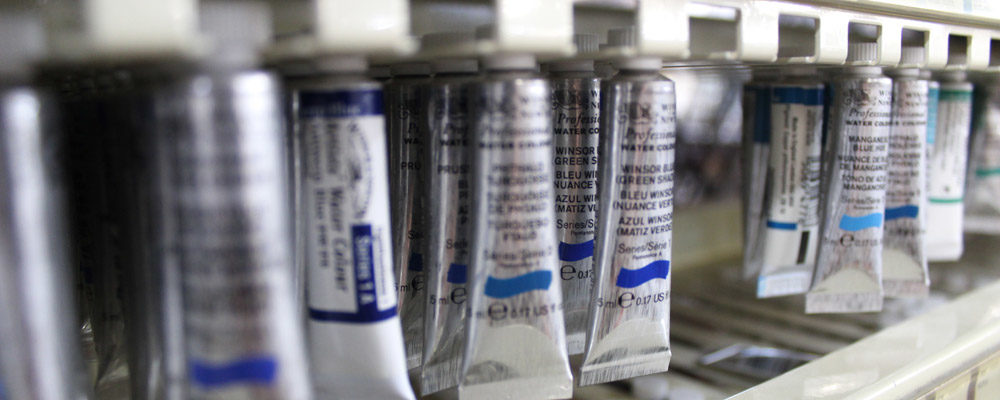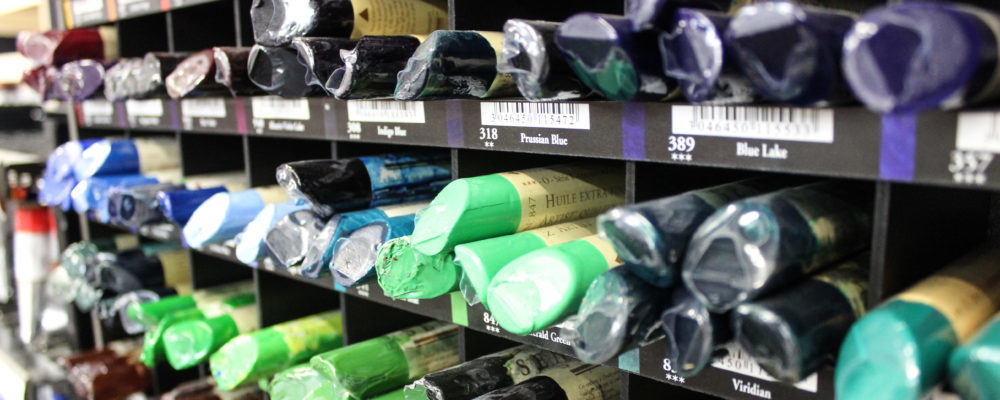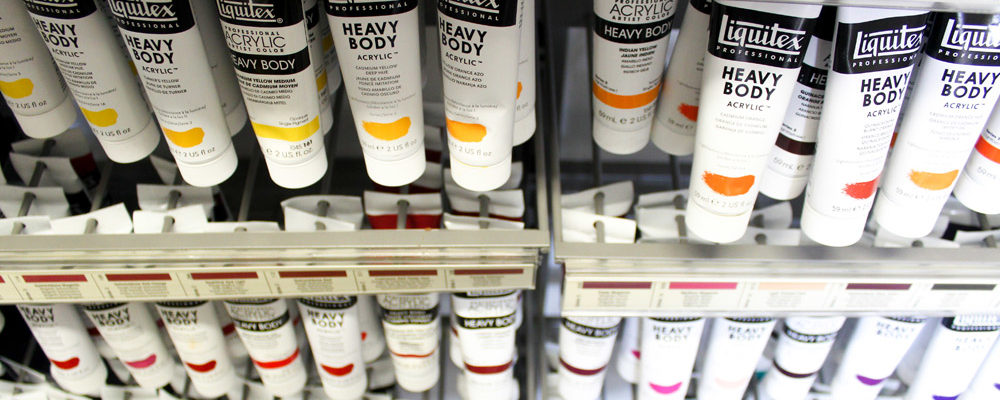Paints and painting are central to visual art and its development over history. Generally speaking, paints are acrylic, water or oil based. One of the most important distinctions to be mindful of when choosing paint is the difference between artist and student quality paint. Student quality paints are made to price, often using synthetic hues to keep paint affordable and costs low. Artist quality paints use genuine pigments as well as higher quality binders and so prices are very dependant on the rarity or scarcity of pigments. As as a result, artist quality paints are priced in series. As a general rule, mediums added to paint work most reliably with artist quality paints as the high quality of the binders and the concentration of the pigments react more predictably. Another benefit of artist quality paints is that they have a higher level of lightfastness and so are less prone to fade over time.
In the history of paint, acrylic is a new kid on the block. Acrylic (polymer-based) paint first emerged in the 1940s as house paint and was quickly recognised by visual artists for its benefits over the traditional, slower drying and generally more arduous medium of oil painting. Acrylic was popular with contemporary art legends like Andy Warhol and David Hockney for its ability to provide a range of effects, from bold and clear images with the sharpness of oil painting to a mimicry of the delicacy and softness that was traditionally achieved by using watercolour. Acrylic paints are generally prized for their versatility and come in a variety of forms that lend themselves better to certain styles for example, heavy body acrylic works well for impasto, where a light bodied acrylic can be useful for airbrush work. Like oil and watercolour paints, there are also a variety of mediums that can be added to artist quality paint for an even more diverse range of effects.
What we stock:
Chromacryl 75mL tubes
A2 120mL tube, 250mL tub or 1L bottle.
Atelier Interactive 80mL tube or 250mL tub
Atelier Free Flow 60mL or 250mL bottle
Jo Sonja 75mL tube or 250mL bottle
Liquitex Heavy Body 59mL tube
Reeves tube sets 12 or 18 10mL tubes
Micador Early Start toddler’s no drip acrylic 250mal tubs.
Historically, gouache is the separated sister of watercolour – it developed without formal recognition for centuries, despite being widely used in visual art since ancient Egyptian times when artists would combine pigments with honey or tranganth glue to create a form of gouache. Opaque when dry but with the characteristics of watercolour when wet, gouache has been proven to be a medium which can create compositions with depth and softness alike. The qualities of gouache are perhaps best seen in masterpieces such as Henri Matisse’s renowned series of blue nudes or the works of François Boucher. As a result of the versatility of this medium, it has been a popular with mixed media as it can effectively complement, oils, water colours and acrylics.
What we stock:
Winsor and Newton 14mL tubes
Caran d’Ache full pan sets in 8, 12 or 15 colours
Reeves sets 12 or 18 10mL tubes
In paint history, oil paints stand out as king. Most probably used since the 13th century, oil paints were developed into the paints that we would recognise (as a specialised blend of pigment with oil) in the modern day by Jan van Eyck during the 15th century and then further improved during the Renaissance period to reflect the aesthetic goals of the era. The expressive capabilities of oil painting has meant that it has remained an extremely popular medium throughout history and remains popular today. The slow drying time of oil paints allow artists to rework areas with ease. Oil paints can even be completely removed from canvas, meaning that as a medium, it can be more forgiving and flexible than acrylic or watercolour.
What we stock:
Art Spectrum 40mL or 150mL tubes.
Winsor and Newton 37mL tubes
Archival Oils 40mL tube
Schminke Norma 35mL tube
Georgian student oils. 38mL or 225mL tube
Reeves sets 12 or 18 10mL tube sets
Oil sticks are oil paint’s less popular friend. Essentially oil paint but solid and in a stick shape, similar to a jumbo pastel, oil sticks are made using oil, wax and pigments compressed together. Though they are not widely used, oil sticks are a striking medium and can create dramatic effects and were actually favoured by famed artist, Jean-Michel Basquiat.
What we stock:
Sennelier Oil Sticks. 38mL
As well as charcoal, our cave painting friends in prehistoric times were using water-based pigments (aka watercolours) and so, arguably, watercolours are the oldest kind of paint. Pigments in a water-based suspension as we know them today, went through evolutionary changes by being used in various civilisations throughout history, most notably the ancient Egyptians, Chinese silk painters and European manuscript illuminations in monasteries, soaring to popularity for upper class European women in the 1700s. Watercolour is famed for it’s ability to aid in accurate and detailed depictions of the natural world and so is the favoured medium for scientific illustration.
Hot tip: for all of you Australian landscape fans, it’s best not to use greens straight from the tube as greens from European brands like Winsor and Newton or Schminke don’t suit an Australian colour palette.
What we stock:
Winsor and Newton 5mL or 14mL tubes
Winsor and Newton Cotmans 8mL tubes or half pans
Schminke Horadam 5mL tubes
Daniel Smith 15mL tubes
Art Spectrum 10mL tubes
Holbein 15mL tubes
Holbein Iridori 15mL tubes
St Petersburg full pans
Koh-I-Noor Travelling Artist pan sets in 12, 18, 24, 30, 36 or 48
Reeves sets 12 or 18 10mL tubes
Micador disc pans in 12, 18 or 24 sets.
Without pigments, we wouldn’t have paint. Period. The history of pigments is super interesting, with some colours being stumbled across accidentally and other going through experiment after experiment to perfect the colour, the secret recipe being guarded fiercely for centuries. True pigments are often made using concentrated mixes of colours taken from nature like carmine, the reddest red, which is made of the blood of parasitic insects or ultramarine which is made from the gemstone, lapis lazuli. As well as being the most important ingredient in paint, pigments can also be bought in powdered form for custom mixing colours.
What we stock:
Art Spectrum dry ground pigments.
Aerosol paints are the bad boys of the painting world. Starting out in the mid-1900s in the USA with utilitarian aspirations for manufacturing, it quickly outgrew those roots to become the medium of choice for protesters and gangs alike. Being quick drying, suited for industrial materials and easy to conceal, spray paints have been favoured as the medium of choice for street and graffiti artists since the 70s, gaining even more popularity in the art world with the rise of British street artist, Banksy. Artist quality aerosol paints are acrylic based and use high quality pigments suspended in gas with a propellant to guarantee lightfastness and durability.
What we stock:
LIQUITEX
Liquitex Acrylic Spray Paint – Artist quality 400mL can.




